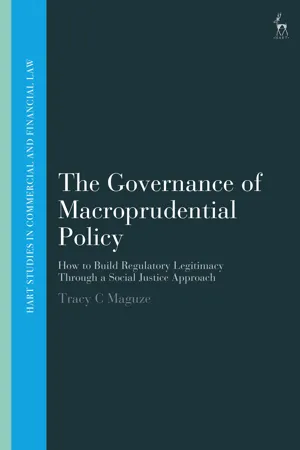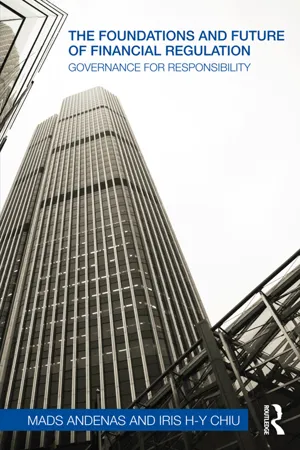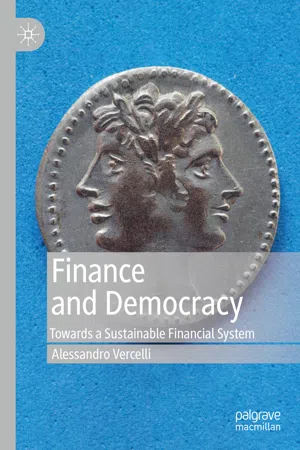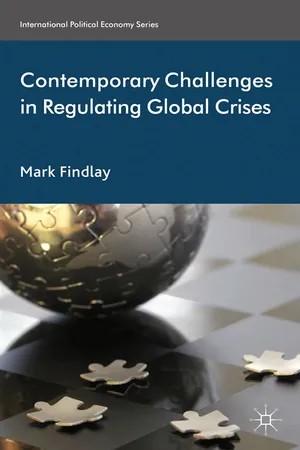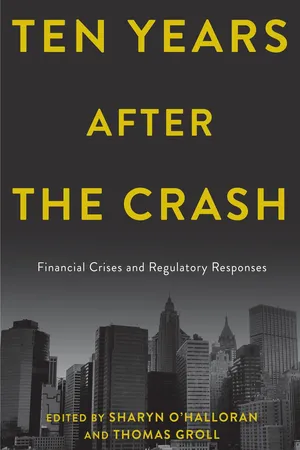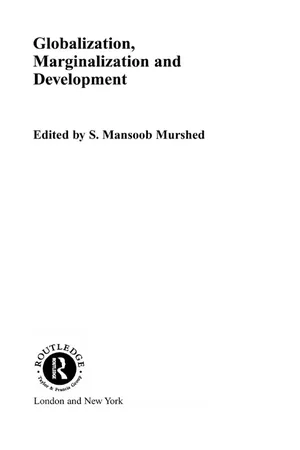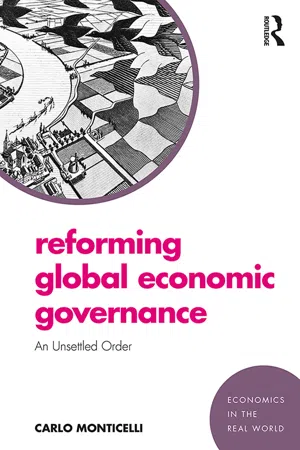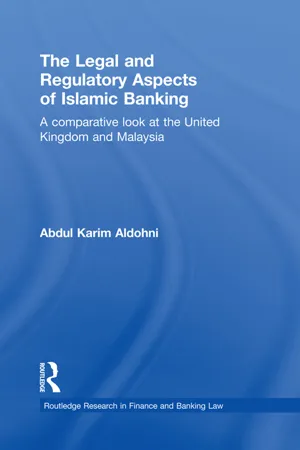Economics
Regulation of Financial System
The regulation of the financial system refers to the set of rules and laws that govern the activities of financial institutions and markets. Its primary goal is to maintain stability, protect consumers, and prevent systemic risks. Regulatory bodies, such as central banks and financial regulatory agencies, oversee and enforce these regulations to ensure the smooth functioning of the financial system.
Written by Perlego with AI-assistance
Related key terms
12 Key excerpts on "Regulation of Financial System"
- Stephany Griffith-Jones, Ricardo Gottschalk, Stephany Griffith-Jones, Ricardo Gottschalk(Authors)
- 2016(Publication Date)
- Routledge(Publisher)
2 Financial regulation, stability and growth in low-income countries A review of the evidence and agenda for research Stephen Spratt IntroductionFor many low income countries, especially in Africa, financial regulation policies constitute the foundation basis for the mechanisms through which financial development exerts a positive impact on economic growth and poverty reduction.(Murinde, 2012)Without effective regulation, financial systems become unstable, potentially triggering crises with devastating effects on the real economy. The continuing impacts of the global financial crisis of 2007–8 show how large these can become. While the avoidance of crises is a necessary condition for productive economic activity to flourish, it is not sufficient. Another more positive side to regulation is one which shapes the evolution of financial structures and influences the ways in which financial actors serve the real economy. The purpose of regulation is thus twofold: to maintain financial stability and to promote inclusive economic growth. Achieving the right balance between these objectives is a delicate, but crucial task. Too great a focus on stability stifles growth, while a headlong dash for growth is very likely to sow the seeds of future crises.The structures of low-income countries’ (LICs) real and financial sectors are different to those in developed countries. Institutional capacity to implement certain kinds of financial regulation is also generally lower. Therefore, the set of regulatory instruments best able to maximise growth, while maintaining stability, should also be different.While this has always been broadly accepted in principle – if rarely in practice – the global financial crisis highlighted a more fundamental issue. Given what we learnt about ‘sophisticated’ finance, it is simply no longer tenable to view the regulatory practices that evolved in the world’s major financial centres as a model to which developing countries should aspire. As regulatory options continue to be re-assessed in developed economies, the time is ripe to do the same in developing countries in general, and LICs in particular.- Maureen Burton, Reynold F. Nesiba, Bruce Brown(Authors)
- 2015(Publication Date)
- Routledge(Publisher)
Regulation must balance the goals of competition and efficiency versus safety and soundness. FIs should balance the expected benefits and expected costs of assuming various levels of risk. Initially, regulation encouraged market segmentation and, hence, regulation was segmented. Although segmented markets are breaking down, regulations have been slower to change. Either financial products or financial institutions can be regulated. The regulatory structure is in the process of ongoing change because of the evolution of the financial services industry.A Proposal to Overhaul the Financial Regulatory Structure
The subprime lending crisis of 2008 that spread to the entire global financial system highlighted lapses in the financial regulatory system. Even before this crisis, policy makers recognized the need to overhaul an outdated regulatory system. The globalization of finance and the plethora of financial innovations had made the financial system very different from what it was a few decades earlier. In March 2007, the U.S. Treasury “convened a blue-ribbon panel to discuss U.S. capital markets competitiveness.” Out of this panel came the recognition that the competitiveness of the financial services industry was negatively impacted by an outdated regulatory structure. Therefore, in June 2007, the Treasury began work on a series of recommendations to modernize the regulatory system.On March 31, 2008, Treasury Secretary Henry Paulson released the “Treasury’s Blueprint for Financial Regulatory Reform.”a The blueprint proposes a new regulatory framework that would be composed of three regulators, each with a different function. The goal of regulating by function was to make the regulatory structure more resilient to innovations within the financial system that could render current regulations inadequate or obsolete.The first regulator would focus on financial stability across the entire financial system. This would protect against systemic risk, which is the risk that a collapse in one market will spread to the rest of the economy and result in a downturn. Not surprisingly, the Treasury recommends that the Fed perform this role. In doing so, the Fed’s regulatory powers would be broadened from financial holding and bank holding companies to investment banks, insurance companies, hedge funds, private equity firms, and virtually any other financial institution or market whose financial practices could pose a threat to the financial stability of the economy. The Fed would have the power to oversee the capital adequacy, liquidity, and lending practices of any such financial institution or market.- eBook - ePub
The Governance of Macroprudential Policy
How to Build Regulatory Legitimacy Through a Social Justice Approach
- Tracy C Maguze(Author)
- 2024(Publication Date)
- Hart Publishing(Publisher)
This chapter has attempted to demonstrate that the nature and magnitude of financial market failures necessitates government intervention in financial markets. However, before intervening, it is critical to identify and calibrate appropriate regulatory solutions because badly designed regulations are likely to cause just as much harm as financial market participants.The way the financial system generates risk, the speed at which this risk migrates across the system (between banks and non-banks alike), and the inadequacy of pursuing financial stability via the safety and soundness of individual institutions suggest that regulations for financial stability should have a different objective, specifically the maintenance of the safety and soundness of the whole system, and ultimately avoid costs to the broader economy.A regulator with a bird’s-eye view of the financial system would require tools that can be calibrated at macro level. Moreover, the tools should be able to tackle the cross-sectional and time dimensions of financial instability. In other words, they should work to reduce interconnections and common exposures to macro risk, while at the same time operating in a countercyclical manner to dampen exuberance during an upswing, but still provide a cushion that allows banks to continue operating should a downswing occur. This is not to say that policy makers should reinvent the wheel and devise completely new tools, current tools in the prudential armoury may suffice if appropriately calibrated and deployed.After the GFC, the world turned to macroprudential policy to fill the gap left by microprudential regulation. Macroprudential policy, as already stated in Chapter 1 - eBook - ePub
Investment and Portfolio Management
A Practical Introduction
- Ian Pagdin, Michelle Hardy(Authors)
- 2017(Publication Date)
- Kogan Page(Publisher)
With financial services groups operating across borders and regional boundaries, the principal regulatory responsibility will lie with the domestic regulator in the home country in which the financial services group or company is based. There will also be subordinate regulatory responsibilities attached to the regulatory supervisor in any other country in which the financial services group or company operates. It is considered to be equally important that ‘over-regulation’ does not stifle the innovation and flexibility of the financial services industry and impose unnecessary burdens and complexity upon the financial markets.Broad regulatory principles followed by the domestic regulators of financial institutions include the following:- competition: supervision should ensure healthy market competition but minimize any harmful consequences and effects;
- management: senior management of financial institutions are monitored and bear responsibility for their decision making;
- innovation: should not be stifled, but financial products and services must be compliant with established rules, regulations and guidelines;
- proportionality: it is expected that regulatory intervention should be proportional to the advantages anticipated from the regulations;
- global markets: regulatory supervision should ensure that internationally agreed standards are maintained.
In this chapter we will focus primarily upon the UK financial regulatory regime, although reference will also be made to other key regulatory regimes in major financial regions as appropriate. It is generally accepted that the principles and importance of financial regulation, if not the minute detail, are applicable globally. However, financial regulation is a substantial and growing cost within the global financial world. - eBook - ePub
Finance in Asia
Institutions, Regulation and Policy
- Qiao Liu, Paul Lejot, Douglas W. Arner(Authors)
- 2013(Publication Date)
- Routledge(Publisher)
For example, the bankruptcy of Lehman Brothers triggered a systemic crisis in the United States, accelerating a loss of economic value and confidence in the global financial system, which soon led to a systemic global crisis. A financial system is regarded as protected from systemic risks when banks and non-bank intermediaries are well-managed, regulated and supervised, adequately capitalized, have strong balance sheets and are well-provisioned for NPLs, and the financial sector has a sound legal and regulatory framework and strong enforcement capacity. Even such an idealized setting can be prone to failure, as the experience of 2008 showed Alan Greenspan, a former Federal Reserve Board chair, not least because of agency problems and distorted incentive structures in the global banking sector, which may have led to excessive leverage and disregard for risk:As a significant example, Greenspan recanted before a US congressional committee only five weeks after Lehman Brothers entered bankruptcy proceedings:those of us who have looked to the self-interest of lending institutions to protect shareholder’s equity (myself especially) are in a state of shocked disbelief. Such counterparty surveillance is a central pillar of our financial markets’ state of balance. If it fails, as occurred this year, market stability is undermined.(Greenspan 2008: lines 384–90)I found a flaw in the model that I perceived is the critical functioning structure that defines how the world works, so to speak. CHAIRMAN: In other words, you found that your view of the world, your ideology, was not right, it was not working? Mr. GREENSPAN. Precisely. That’s precisely the reason I was shocked, because I had been going for 40 years or more with very considerable evidence that it was working exceptionally well.(ibid: lines 854–63)4.3 Monetary policy and central banking
Commercial and central banks are intimate partners – sometimes amicable, sometimes in conflict. Their relationship is important in several ways, including bank and central bank governance, the operations of monetary policy, and in the central bank’s interest in domestic stability and international cooperation with its peers. Central banks stand at the core of the national financial system.1 - eBook - ePub
The Foundations and Future of Financial Regulation
Governance for Responsibility
- Mads Andenas, Iris H-Y Chiu(Authors)
- 2013(Publication Date)
- Routledge(Publisher)
139 This potential trajectory in financial regulation could be pertinent to states desperately managing their levels of sovereign debt, which have become a source of financial instability in a number of euro area countries. For example, micro-prudential regulation that ties capital adequacy and liquidity regulation to holdings of sovereign debt regarded as ‘safe’ or ‘liquid’ may be a tool for maintaining the market in sovereign debt. The perceived safety of euro area banks bolstered by regulation may also contribute to a friendlier climate for sovereign debt auctions. The next section turns to whether the financial stability objective may be coupled with monetary policy and central bank functions in the UK and the EU.139 Sofía Perez and Jonathan Westrup, ‘Finance and the Macro-economy: The Politics of Regulatory Reform in Europe’ (2008) CES Working Paper No 156 http://aei.pitt.edu/9005/ accessed 14 December 2012.2.4 Financial regulation as a tool for domestic economic policy and its relationship to monetary policy
Loose monetary policy in the United States in the decades leading up to the global financial crisis has been argued to be relevant to excessive levels of risk-taking by banks, contributing to the scale of the crisis in 2008–9.140 Although it has been the trend to separate banking/financial regulation from central banking, the connections between financial regulation and monetary policy are being revisited in order to ascertain how they may work together to deliver financial stability. In the UK, financial regulation has been separate from central banking since 1997, when banking supervision moved from the Bank of England to the FSA. In the EU, the European Central Bank (ECB) has been established as an independent body with a distinct mandate and this has not included financial regulation. However, important synergies have been lost in the removal of financial regulation from central banking and, in both the UK and EU, there are now reforms to re-establish the central bank’s role in preserving financial stability alongside its role in monetary policy.141 Both the Bank of England and the ECB will assume responsibility in micro-prudential supervision. The Prudential Regulation Authority (PRA), a subsidiary of the Bank of England, has been created to carry out micro-prudential oversight in the UK from mid-2013. The ECB will assume the role of micro-prudential supervisor for euro area banks and banks in non-euro area countries that are willing to subject themselves to its oversight (the Single Supervisory Mechanism, to be in force from 2014). The role of macroprudential supervision (discussed in detail in Part 4 - eBook - ePub
Finance and Democracy
Towards a Sustainable Financial System
- Alessandro Vercelli(Author)
- 2019(Publication Date)
- Palgrave Macmillan(Publisher)
regulation , often obtaining worse results.This apparent paradox requires an explanation. Pure self-regulation , as foreshadowed by Adam Smith and modelled a century later through the general equilibrium approach, is the unintended result of myriads of decisions taken by single decision makers in their own interest. However, in the actual markets the agents have to cope with a host of market imperfections .38 In particular, market actors have to take decisions conditional to the expected behaviour of other agents that asymmetric information and strong uncertainty makes unforeseeable. Counterparty risk is a significant and ubiquitous case in point. That is why financial companies, in their own interest, are not necessarily hostile to some sort of institutional mechanism pressing all economic units to comply with basic rules of information disclosure and fair financial behaviour. This provided in the past the rationale and the mainspring of vicarious regulation . In particular, this explains the establishment of BIS, the central bank of central banks managing the Basel Accord, and more recently of the Financial Stability Board coordinating reforms and standards of the global financial system . What is important for financial institutions is that the regulatory, supervisory, and standard-setting institutions do not escape from their direct influence. However, the financial lobbies seem today so worried by the prospect of binding re-regulation of the financial system by public authority that they prefer to focus on the preventive argument that any regulation would distort and impair their beneficial contribution to the growth of the economy. Under these contradictory pressures, vicarious regulation tried to conform to the market standards of decentralisation and flexibility by establishing bespoke rules for different subjects and circumstances. The G20 chose to entrust the management of this ever-growing multilayered structure of rules to a multiplying army of institutions (not only central banks but also new institutions such as the Financial Stability Board ). The outcome was a sort of casuistic overregulation that financial institutions perceive as hermetic, oppressive, and unmanageable. This is especially the case of small local institutions that play a crucial role in the financial support of the real economy - M. Findlay(Author)
- 2013(Publication Date)
- Palgrave Macmillan(Publisher)
Following the recent global financial collapses and facing the imminence of further economic crises in the world of the future, new life is breathed into the debate surrounding financial sector reform. The aspects of reform which have become increasingly less problematic include:• improving the governance of financial regulation; • ensuring the independence of critical regulatory elements and agencies; • broadening the regulator’s intellectual perspective; • developing a more pluralistic and inclusive regulatory mix; • being ever vigilant against regulatory capture; • introducing extra-financial considerations such as social responsibility into the intended regulatory outcomes; • avoiding an overreliance on the extremes of ungoverned self-regulation, or overbearing state interventionAt a functional level, the impact of regulatory reform requires effective monitoring (see Chapter 9 ). As the later discussion of regulatory accountability reiterates, this is best achieved within a framework of mutuality and regulatory community. Representation of key interests is not denied where sociability is preferred, and the accountability framework compatible with collaborative regulation may include proxy advocates, technical experts, agency monitors, designated consumer representatives and even ombudsmen.Institutional competitivenessOne of the reasons why financial markets have been prone to collapse in cycles is the paucity of genuine institutional competitiveness between financial institutions. As the age of financial deregulation dawned in the 1980s, one of the arguments in its favour, opening up financial markets to competitive efficiencies, was swiftly snuffed out as banks in particular consolidated and globalised. Financial industries moved rapidly beyond their national origins and obligations and at a time when fiscal policy was burgeoning as the referred economic technology of developed nations, the mechanisms through which that policy was to be exercised were increasingly beyond state control.Banking consolidation was accompanied by the colonisation by banks of a vast range of financial products and services previously not considered the province of banking. This further undermined competition in the financial services market, narrowing supply diversity and demand choice.- eBook - ePub
After the Crash
Financial Crises and Regulatory Responses
- Sharyn O'Halloran, Thomas Groll(Authors)
- 2019(Publication Date)
- Columbia University Press(Publisher)
system, its parts connected in myriad ways, including via the real economy and across countries. As George Blunden, the first chairman of the Basel Supervisors Committee, said over thirty years ago:[I]t is part of the [supervisor’s] job to take [a] wider systemic view and sometimes to curb practices which even prudent banks might, if left to themselves, regard as safe.15In consequence, it is difficult, although not impossible, to separate responsibility for system stability from micro-prudential supervision.16 Further, unless society wills a zero-failures policy, which would be neither desirable nor feasible, the prudential regime, properly conceived, needs to embrace recovery planning and, even more important, resolution planning.Under this approach, policymakers need to determine the severity of shock that the system should be able to withstand. In principle, that would be driven by three things:One obvious conclusion is that the standard micro-prudential statutory objective of ensuring the “safety and soundness” of individual intermediaries needs to be framed explicitly in terms of system resilience and stability. The United States did not do that explicitly in its 2010 reforms. Two years later, perhaps benefiting from having more time to think and a legislative process less affected by negotiation to placate local interests, the United Kingdom did so. The safety and soundness objective of the Bank of England’s micro-prudential supervisors is cast in terms of ensuring intermediaries carry on business in ways that avoid adverse effects on stability, and of minimizing the expected effect of their failure on stability. - eBook - ePub
- Mansoob Murshed(Author)
- 2002(Publication Date)
- Routledge(Publisher)
2 Financial sector regulation in a globalized context
S. Mansoob Murshed and Djono SubagjoIn his presidential address to the American Economics Association, Milton Friedman gave us the authoritative version of the monetarist creed:…monetary policy can prevent money itself from being a major source of economic disturbance… A second thing monetary policy can do is to provide a stable background for the economy. Milton Friedman (1968: 12–13)This statement has become the cornerstone of macroeconomic policy advice dispensed to all developing and transitional economies. It also constitutes the raison d’être for the primacy of inflation control, as well as the stabilization and structural adjustment programmes of the 1980s, and the associated liberalization of financial markets. But as we all know, with hindsight, this view (generally described as the Washington consensus) ignored the need for prudential regulation of the financial sector as a prerequisite for sound monetary policy. The converse is equally true: stable monetary policies are needed if an efficient financial sector is to flourish. Simple (or simple-minded) capital account liberalization, as part of a strategy of integration into the global economy, has become discredited in the wake of the Asian crisis of 1997 (see Rodrik 1998). In addition, it is recognized that monetary policy reform geared to controlling inflation will not benefit the economy fully unless and until the private financial sector is well functioning. Also in the presence of many other distortions in the economy, financial liberalization may be undesirable, due to second-best considerations. The over-arching problem lies in the weak nature of institutions and the type of strategic interaction between the state and various groups in developing countries (LDCs).This chapter aims to make a policy-oriented contribution to the literature on prudential bank regulation for LDCs. It does three things: first, it argues that there is a need to place banking sector regulation high on the policy agenda. Second, it provides some theoretical insights, emphasizing the difficulties of the regulation process. Finally, it critically analyses policy advice in a taxonomic style with regard to prudential regulation, paying close attention to the capabilities of lowincome and small LDCs. The first section examines the need to pay attention to banking regulation, the second section is devoted to the theoretical and policy analysis on bank regulation, and, finally, the third section concludes with policy recommendations. - eBook - ePub
Reforming Global Economic Governance
An Unsettled Order
- Carlo Monticelli(Author)
- 2019(Publication Date)
- Routledge(Publisher)
Conventionally, the international standards relevant to financial stability are grouped into three areas. The first one regards the transparency of macroeconomic policies and data. It includes principles that should be adhered to in: i) compiling and disseminating economic, financial, and socio-demographic harmonized statistics; ii) adopting practices so as to provide a clear picture of the structure and finances of government; iii) ensuring transparency in the conduct of monetary and financial policies; and iv) producing and disseminating information in order to access international capital markets. 5 The second area focuses on financial regulation and supervision, and covers standards to define the framework for: i) the supervision of the insurance sector; ii) the sound prudential regulation and supervision of banks and banking systems; and iii) securities regulation protecting investors, reducing systemic risk, and ensuring that markets are fair, efficient, and transparent. 6 The third area covers institutional and market infrastructure, and comprises standards defining: i) independent auditors’ responsibilities; ii) the legal, institutional, and regulatory framework that influences corporate governance; iii) benchmarks to assess the quality of deposit insurance systems; iv) the features of systemically important payment systems, central securities depositories, securities settlement systems, central counterparties, and trade repositories as well as the responsibilities of the respective supervising authorities; v) the legal, regulatory, and operational measures for combating money laundering and the financing of terrorism; vi) ways to evaluate and improve insolvency and creditor/debtor regimes; and vii) a single set of accounting standards to be applied on a globally consistent basis. 7 On the other hand, if the international standards regime complemented by a pivotal forum bringing together the - eBook - ePub
The Legal and Regulatory Aspects of Islamic Banking
A Comparative Look at the United Kingdom and Malaysia
- Abdul Karim Aldohni(Author)
- 2012(Publication Date)
- Routledge(Publisher)
The Economic Journal 698–707.10 It must be noted that the objectives of banking regulation may vary based on the economic plans that have been made by the financial authorities. In other words, the objectives are tailored in the way that serves the economic plans in general.11 David Llewellyn, ‘The Rational for Financial Regulation’, Financial Services Authority (Occasional Paper Series 1, April 1999), p 8, www.fsa.gov.uk/pubs/occpapers/Op01.pdf [12/04/07].12 Peter Cartwright, Banks, Consumer and Regulation (Hart Publishing: Oxford and Portland, OR, 2004), p 19. It must be noted that the rationales discussed in the literature have been described as the rationales for financial regulation in general. However the following discussion will elucidate these motivations with special reference to the banking sector case.13 Heffernan explains more the private and social costs as follows: ‘… the private costs from collapse of a financial firm are incurred by investors, depositors, employees and in some cases, customers of the bank. Social costs are incurred if the financial sector collapse because the economy loses its system of financial intermediation and money transmission.’ See Shelagh Heffernan, Modern Banking (John Wiley & Sons: Chichester, 2005), p 176, n 4.14 David Llewellyn, ‘The Rationale for Financial Regulation’, Financial Services Authority (Occasional Paper Series 1, April 1999), p 13.15 Peter Cartwright, Banks, Consumer and Regulation (Hart Publishing: Oxford and Portland, OR, 2004), p 16.16 David Llewellyn, ‘The Rationale for Financial Regulation’, Financial Services Authority (Occasional Paper Series 1, April 1999), pp 13–14.17 Charles Goodhart, The Evolution of Central Banks (The MIT Press, 1988), p 57.18 David Llewellyn, op cit pp 21 and 25.19 George A. Akerlof, ‘The Market for “Lemons”: Quality, Uncertainty and the Market Mechanism’ (1970) 84, 3 The Quarterly Journal of Economics
Index pages curate the most relevant extracts from our library of academic textbooks. They’ve been created using an in-house natural language model (NLM), each adding context and meaning to key research topics.


